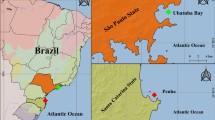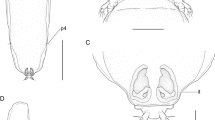Abstract
Myxozoans of the family Ceratomyxidae are common coelozoic parasites of marine, anadromous, and freshwater fish, and may also be found, less frequently, parasitizing the tissue of these hosts. The diversity and ecology of the freshwater species of the genus Ceratomyxa have been poorly investigated, leading to a knowledge gap that restricts the understanding of the distribution and prevalence of this group of parasites. In the present study, parasites were found inside vermiform plasmodia, characterised by oscillatory movements in the characiform species Hemiodus unimaculatus. The crescent-shaped and elongated spores, perpendicular to the suture line, have a mean length of 28.9 ± 2.7 μm and width of 2.6 ± 0.1 μm, with two symmetrical oval polar capsules, 1.9 ± 0.3 μm in length and 1.7 ± 0.2 μm in width, containing polar filaments with three or four coils, located near the central suture, with symmetrical lateral elongations 14.3 ± 1.1 μm in length and binucleate amoeboid sporoplasm. The integrated comparative analysis of the morphological characteristics and partial SSU rRNA sequences supported the identification of a new species of coelozoic Ceratomyxa, found in the gallbladder of H. unimaculatus, from the Tocantins basin, in the municipalities of Estreito and Imperatriz in eastern Brazilian Amazonia.The new species was denominated Ceratomyxa fonsecai n. sp.




Similar content being viewed by others
References
Adriano EA, Okamura B (2017) Motility, morphology and phylogeny of the plasmodial worm, Ceratomyxa vermiformis n. sp. (Cnidaria: Myxozoa: Myxosporea). Parasitology 144:158–168. https://doi.org/10.1017/S0031182016001852
Azevedo C, Rocha S, Casal G, Clemente SC, Matos P, Al-Quraishy S, Matos E (2013) Ultrastructural description of Ceratomyxa microlepis sp. nov. (Phylum Myxozoa): a parasite infecting the gall bladder of Hemiodus microlepis, a freshwater teleost from the Amazon River. Mem Inst Oswaldo Cruz 108(2):150–154. https://doi.org/10.1590/0074-0276108022013004
Barta JR, Martin DS, Liberator PA, Dashkevicz M, Anderson JW, Feighner SD, Elbrecht A, Perkins-Barrow A, Jenkins MC, Danforth HD, Ruff MD, Profous-Juchelka H (1997) Phylogenetic relationships among eight Eimeria species infecting domestic fowl inferred using complete small subunit ribosomal DNA sequences. J Parasitol 83:262–271. https://doi.org/10.2307/3284453
Bartošová-Sojková P, Lövy A, Reed CC, Lisnerová M, Tomková T, Holzer AS, Fiala I (2018) Life in a rock pool: Radiation and population genetics of myxozoan parasites in hosts inhabiting restricted spaces. PLOS One 13(3):e0194042. https://doi.org/10.1371/journal.pone.0194042
Brooks S, Gelman A, Jones GL, Meng X (2011) Handbook of Markov Chain Monte Carlo. CRC Press, New York. https://doi.org/10.1201/b10905
Carriero MM, Adriano EA, Silva MRM, Ceccarelli PS, Maia AAM (2013) Molecular phylogeny of the Myxobolus and Henneguya genera with several new South American species. PLoS One 8:e73713. https://doi.org/10.1371/journal.pone.0073713
Castro LR, Austin AD, Dowton M (2002) Contrasting rates of mitochondrial molecular evolution in parasitic diptera and hymenoptera. MolBiolEvol 19(7):1100–1113. https://doi.org/10.1093/oxfordjournals.molbev.a004168
Diamant A, Whipps CM, Kent ML (2004) A new species of Sphaeromyxa (Myxosporea: Sphaeromyxina: Sphaeromyxidae) in devil firefish, Pterois miles (Scorpaenidae), from the northern Red Sea: morphology, ultrastructure, and phylogeny. J Parasitol 90:1434–1442. https://doi.org/10.1645/GE-336R
Drummond AJ, Rambaut A (2007) BEAST: Bayesian evolutionary analysis by sampling trees. BioMed Cent Evol Biol 7:214. https://doi.org/10.1186/1471-2148-7-214
Drummond AJ, Ho SYW, Phillips MJ, Rambaut A (2006) Relaxed phylogenetics and dating with confidence. PLoS Biol 4:e88. https://doi.org/10.1371/journal.pbio.0040088
Drummond AJ, Suchard MA, Xie D, Rambaut A (2012) Bayesian phylogenetics with BEAUti and the BEAST 1.7. Mol Biol Evol 29:1969–1973. https://doi.org/10.1093/molbev/mss075
Eiras J (2006) Synopsis of the species of Ceratomyxa Thélohan, 1892 (Myxozoa: Myxosporea: Ceratomyxidae). Syst Parasitol 65(1):49–71. https://doi.org/10.1007/s11230-006-9039-5
Eiras JC, Cruz C, Saraiva A (2018) Synopsis of the species of Ceratomyxa Thélohan, 1892 (Cnidaria, Myxosporea, Ceratomyxidae) described between 2007 and 2017. Syst Parasitol (2018) 95(5):427–446. https://doi.org/10.1007/s11230-018-9791-3
Evans NM, Holder MT, Barbeitos MS, Okamura B, Cartwright P (2010) The phylogenetic position of Myxozoa: exploring conflicting signals in phylogenomic and ribosomal data sets. MolBiolEvol 27(12):2733–2746. https://doi.org/10.1093/molbev/msq159
Ferguson JA, Atkinson SD, Whipps CM, Kent ML (2008) Molecular and morphological analysis of Myxobolus spp. of salmonid fishes with the description of a new Myxobolus species. J Parasitol 94:1322–1334. https://doi.org/10.1645/GE-1606.1
Fiala I, Bartosova P (2010) History of myxozoan character evolution on the basis of rDNA and EF-2 data. BMC Evol Biol 10:228. https://doi.org/10.1186/1471-2148-10-228
Garbouj M, Rangel LF, Santos MJ, Bahri S (2018) Ceratomyxa gouletti n. sp. (Myxosporea: Ceratomyxidae), um parasita do peixe-escorpião vermelho Scorpaena scrofa (L.) das águas da Tunísia. Parasitol Res 117(6):1933–1939. https://doi.org/10.1007/s00436-018-5888-5
Gatto L, Catanzaro D, Milinkovitch MC (2007) Assessing the applicability of the GTR nucleotide substitution model through simulations. Evol Bioinform Online 2:145–155. https://doi.org/10.1177/117693430600200020
Gentil-Vasconcelos HC, Dias MT (2014) Influência da sazonalidade na infestação de Ergasilus turucuyus (Copepoda: Ergasilidae) em Acestrorhynchus falcirostris e Hemiodus unimaculatus (Osteichthyes: Characiformes) do reservatório Coaracy Nunes, estado do Amapá, Brasil. Biota Amazônia 4(1):106–110. https://doi.org/10.18561/2179-5746/biotaamazonia.v4n1p106-110
Gunter NL, Whipps CM, Adlard RD (2009) Ceratomyxa (Myxozoa: Bivalvulida): robust taxon or genus of convenience? Int J Parasitol 39:1395–1405. https://doi.org/10.1016/j.ijpara.2009.04.008
Hall TA (1999) BioEdit: a user-friendly biological sequence alignment editor and analysis program for Windows 95/98/NT. Nucleic Acids Symp 41:95–98
Heiniger H, Adlard RD (2013) Molecular identification of cryptic species of Ceratomyxa Thélohan, 1892 (Myxosporea: Bivalvulida) including the description of eight novel species from apogonid fishes (Perciformes: Apogonidae) from Australian waters. ActaParasitol 58(3):342–360. https://doi.org/10.2478/s11686-013-0149-3
Heiniger H, Gunter NL, Adlard RD (2008) Relationships between four novel ceratomyxid parasites from the gall bladders of labrid fishes from Heron Island. Australia Parasitol Int 57:158–165. https://doi.org/10.1016/j.parint.2007.11.006
Holzer AS, Wooten R, Sommerville C (2007) The secondary structure of the unusually long 18S ribosomal RNA of the myxozoan Sphaerospora truttae and structural evolutionary trends in the Myxozoa. Int J Parasitol 37:1281–1295. https://doi.org/10.1016/j.ijpara.2007.03.014
Kaur H, Attri R, Joshi J (2016) Molecular identification of a new myxozoan, Myxobolus dermiscalis n. sp. (Myxosporea) infecting scales of Labeo rohita Hamilton in Harike Wetland, Punjab (India). Int J Parasitol Parasites Wildl 5:139–144. https://doi.org/10.1016/j.ijppaw.2015.10.003
Kovaleva AA (1988) Subordem Sphaeromyxina (Myxosporea, Bivalvulida) sua estrutura e lugar na classificação myxosporidian. Zool Zh 67: 1616-1620. Langeani F (2003) Family Hemiodontidae (Hemiodontids). Pp. 96-100. In: Reis, R E., Kullander, SO., Ferraris, CJ. Check list of the freshwater fishes of South and Central America. Porto Alegre, Edipucrs, 729p.
Langeani F (2004) Hemiodus jatuarana, uma nova espécie de Hemiodontidae do rio Trombetas, Bacia Amazônica, Brasil (Teleostei, Characiformes). Zootaxa 546(1):1–6. https://doi.org/10.11646/zootaxa.546.1.1
Lom J, Arthur JR (1989) A guideline for the preparation of species descriptions in Myxosporea. J. Fish Dis 12:151–156. https://doi.org/10.1111/j.1365-2761.1989.tb00287.x
Luna LG (1968) Manual of Histologic Staining Methods of the Armed Forces Institute of Pathology, 3rd edn. American Registry of Pathology, Washington 258 p
Mathews PD, Naldoni J, Maia AAM, Adriano EA (2016) Morphology and small subunit rDNA-based phylogeny of Ceratomyxa amazonensis n. sp. parasite of Symphysodondiscus, an ornamental freshwater fish from Amazon. Parasitol Res 115:4021–4025. https://doi.org/10.1007/s00436-016-5173-4
Mooers A, Gascuel O, Stadler T, Li H, Steel M (2012) Branch lengths on birth-death trees and the expected loss of phylogenetic diversity. Syst Biol 61:195–203. https://doi.org/10.1093/sysbio/syr090
Okamura B, Gruhl A, Bartholomew JL (2015) Myxozoan evolution, ecology and development. Springer International Publishing 441p. https://doi.org/10.1007/978-3-319-14753-6
Palenzuela O, Sitjà-Bobadilla A, Alvarez-Pellitero P (1997) Ceratomyxa sparusaurati (Protozoa: Myxosporea) infections in cultured gilthead sea bream Sparu saurata(Pisces: Teleostei) from Spain: Aspects of the host parasite relationship. Parasitol Res 83(6):539–548
Posada D (2008) jModelTest: phylogenetic model averaging. Mol Biol Evol 25:1253–1256. https://doi.org/10.1093/molbev/msn083
Rambaut A (2012) FigTree version 1.4.0.
Rambaut A, Drummond AJ, Xie D, Baele G, Suchard MA (2018) Posterior summarisation in Bayesian phylogenetics using Tracer 1.7. Syst Biol 67:901–904. https://doi.org/10.1093/sysbio/syy032
Reed CC, Basson L, Van As LL, Dykova I (2007) Four new myxozoans (Myxosporea: Bivalvulida) from intertidal fishes along the south coast of Africa. Folia Parasitol 54(4):283–292. https://doi.org/10.14411/fp.2007.037
Reis RE, Kullander SO, Ferraris SJ (2003) Check-List of the Freshwater Fishes of South and Central America.EDIPUCRS, Porto Alegre, 742 p.
Rocha S, Rangel LF, Castro R, Severino R, Azevedo C, Santos MJ, Casal G (2016) Ultrastructure and phylogeny of Ceratomyxa diplodae (Myxosporea: Ceratomyxidae), from gallbladder of European sea bass Dicentrarchus labrax. DisAquatOrg 121:117–128. https://doi.org/10.3354/dao03049
Silva-Júnior ACS (2014) Estudo morfológico de myxosporídio em Hemiodus unimaculatus BLOCH, 1794 (Characiforme: Hemiodontidae) oriundos do município de Ferreira Gomes/AP. Biota Amazônia 4(1):9–14. https://doi.org/10.18561/2179-5746/biotaamazonia.v4n1p9-14
Sitjà-Bobadilla A, Alvarez-Pellitero P (1993) Light and electron microscopic description of Ceratomyxa labracis n.sp. and redescription of C. diplodae (Myxosporea, Bivalvulida) from wild and cultured Mediterranean sea bass (Dicentrarchus labrax L.). SystParasitol 26(3):215–223. https://doi.org/10.1007/BF00009729
Swofford DL (2003) PAUP: Phylogenetic Analysis Using Parsimony (and othermethods).Version 4.10b. Sinauer Associates, Sunderland.
Thabet A, Mansour L, Al Omar SY, Tlig‐Zouari S (2016) Ceratomyxa tunisiensis n. sp. (Myxosporea: Bivalvulida) from the Gallbladders of Two Carangid Fish Caught Off the Coast of Tunisia. J Eukaryot Microbiol 63:86–92. https://doi.org/10.1111/jeu.12251
Videira M, Velasco M, Malcher CS, Santos P, Matos P, Matos E (2016) An outbreak of myxozoan parasites in farmed freshwater fish Colossoma macropomum (Cuvier, 1818) (Characidae, Serrasalminae) in the Amazon region, Brazil. Aquac Rep 3:31–34. https://doi.org/10.1016/j.aqrep.2015.11.004
Whipps CM, Adlard RD, Bryant MS, Lester RJG, Findlay V, KEnt ML (2003) First report of three Kudoa species from eastern Australia: Kudoa thyrsites from mahimahi (Coryphaena hippurus), Kudoa amamiensis and Kudoa minithyrsites n. sp. from sweeper (Pempherisy psilychnus). J EukuryotMicrobiol 50:215–219. https://doi.org/10.1111/j.1550-7408.2003.tb00120.x
Zatti SA, Atkinson SD, Bartholomew JL, Maia AAM, Adriano EA (2017) Amazonian waters harbour an ancient freshwater Ceratomyxa lineage (Cnidaria: Myxosporea). ActaTropica 169:100–106. https://doi.org/10.1016/j.actatropica.2017.02.006
Zatti S, Atkinson S, Maia A, Bartholomew J, Adriano E (2018) Ceratomyxa gracillima n. sp. (Cnidaria: Myxosporea) provides evidence of panmixia and ceratomyxid radiation in the Amazon basin. Parasitology 145(9):1137–1146. https://doi.org/10.1017/S0031182017002323
Funding
The National Council for Scientific and Technological Development—CNPq supported this study financially (Universal Programme, 441645-2014-3; Productivity in Research, No. 301497/2016-8). We are also grateful for the support provided by State University of the Tocantina Region of Maranhão—UEMASUL and Maranhão State Research Foundation—FAPEMA.
Author information
Authors and Affiliations
Corresponding author
Ethics declarations
The analytical procedures were approved by the Ethics Committee for the Experimental Use of Animals of the Federal Rural University of Amazonia (CEUA/UFRA no. 013/2014).
Conflict of interest
The authors declare that they have no conflicts of interest.
Additional information
Section Editor: Astrid Holzer
Publisher’s note
Springer Nature remains neutral with regard to jurisdictional claims in published maps and institutional affiliations.
Electronic supplementary material
Rights and permissions
About this article
Cite this article
da Silva, M.F., de Carvalho, A.E.F.B., Hamoy, I. et al. Coelozoic parasite of the family Ceratomyxidae (Myxozoa, Bivalvulida) described from motile vermiform plasmodia found in Hemiodus unimaculatus Bloch, 1794. Parasitol Res 119, 871–878 (2020). https://doi.org/10.1007/s00436-019-06505-5
Received:
Accepted:
Published:
Issue Date:
DOI: https://doi.org/10.1007/s00436-019-06505-5




